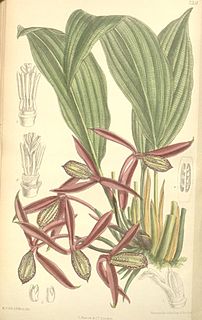
Orchidantha is a genus of flowering plants. In the APG III system, it is placed in the family Lowiaceae, as the sole genus. It includes the plants in the formerly recognised genera Lowia and Protamomum.

Arisaema is a large and diverse genus of the flowering plant family Araceae. The largest concentration of species is in China and Japan, with other species native to other parts of southern Asia as well as eastern and central Africa, Mexico and eastern North America. Asiatic species are often called cobra lilies, while western species are often called jack-in-the-pulpit; both names refer to the distinctive appearance of the flower, which consists of an erect central spadix rising from a spathe.
Lasiococca is a plant genus of the family Euphorbiaceae first described in 1887. These are small to relatively large trees found in scrubs or semi-evergreen forests. They grow in India, Indochina, Southeast Asia, and southern China.
- Lasiococca brevipes(Merr.) Welzen & S.E.C.Sierra - Peninsular Malaysia, Philippines, Lesser Sunda Islands, Sulawesi
- Lasiococca chaniiThin - Vietnam
- Lasiococca comberiHaines - Hainan, Yunnan, Vietnam, Thailand, E India
- Lasiococca lociiThin - Vietnam
- Lasiococca symphylliifolia(Kurz) Hook.f. - Sikkim
Epiprinus is a genus of plant of the family Euphorbiaceae first described as a genus in 1854. It is native to Indochina, Sumatra, southern China, and the Indian Subcontinent.
- Epiprinus balansae(Pax & K.Hoffm.) Gagnep. - Vietnam
- Epiprinus lanceifoliusCroizat - Vietnam
- Epiprinus malayanusGriff. - Myanmar, Thailand, Peninsular Malaysia, Sumatra
- Epiprinus mallotiformis(Müll.Arg.) Croizat - southern India
- Epiprinus poilaneiGagnep. - Vietnam
- Epiprinus siletianus(Baill.) Croizat - Hainan, Yunnan, Assam, Laos, Myanmar, Thailand, Vietnam
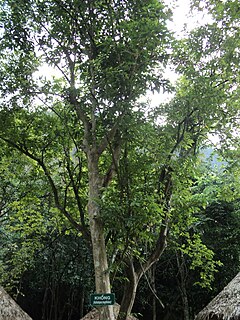
Koilodepas is a genus of plant of the family Euphorbiaceae first described as a genus in 1856. It is native to Southeast Asia, India, Hainan, and New Guinea.
Cnesmone is a genus of plant of the family Euphorbiaceae first described as a genus in 1826. It is native to southern China and to much of Southeast Asia.
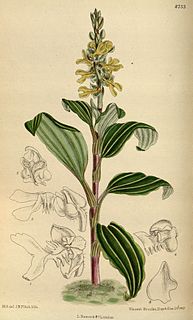
Odontochilus is a small genus from the orchid family (Orchidaceae). These terrestrial, mycoparasitic orchids occur from China, Japan, the Himalayas, Southeast Asia, New Guinea and Melanesia. The genus is related to Gonatostylis, endemic to New Caledonia.

Daphniphyllum is the sole genus in the flowering plant family Daphniphyllaceae and was described as a genus in 1826. The genus includes evergreen shrubs and trees mainly native to east and southeast Asia, but also found in the Indian Subcontinent and New Guinea.

Pothos is a genus of flowering plants in the family Araceae. It is native to China, the Indian Subcontinent, Australia, New Guinea, Southeast Asia, and various islands of the Pacific and Indian Oceans.
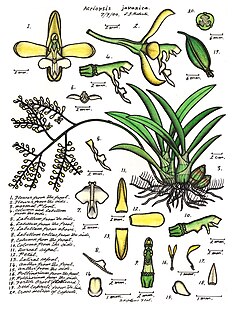
Acriopsis, commonly known as chandelier orchids or 合萼兰属 is a genus of flowering plants in the family Orchidaceaes. Orchids in this genus are epiphytic herbs with spherical or cylindrical pseudobulbs, creeping, branched rhizomes, thin white roots, two or three leaves and many small flowers. The flowers are non-resupinate with the lateral sepals joined along their edges and have spreading petals and a three-lobed labellum. The column has projections that extend hood-like beyond the anther.
Amydrium is a genus of flowering plants in the family Araceae that is native to Southeast Asia, southern China, and New Guinea.
Anadendrum is a genus of flowering plants in the family Araceae. It is native to China and Southeast Asia.

Hapaline is a genus of flowering plants in the family Araceae. It contains 7 species that are found from southern China to Borneo.
Pelatantheria is a genus of flowering plants from the orchid family, Orchidaceae. Its species are distributed across China, Japan, the Indian Subcontinent and Southeast Asia.
- Pelatantheria bicuspidataTang & F.T.Wang - Yunnan, Guizhou, Thailand
- Pelatantheria cristata(Ridl.) Ridl. - Thailand, Malaysia, Sumatra
- Pelatantheria ctenoglossumRidl. - Yunnan, Indochina
- Pelatantheria eakroensisHaager - Vietnam
- Pelatantheria insectifera(Rchb.f.) Ridl. - Assam, Bangladesh, India, Nepal, Bhutan, Andaman Islands, Myanmar, Thailand, Vietnam
- Pelatantheria rivesii(Guillaumin) Tang & F.T.Wang - Yunnan, Guangxi, Laos, Vietnam
- Pelatantheria scolopendrifolia(Makino) Aver. - Japan, Korea, Anhui, Fujian, Jiangsu, Shandong, Sichuan, Zhejiang
- Pelatantheria woonchengiiP.O'Byrne - Thailand
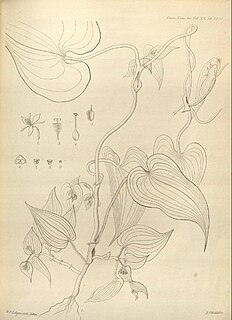
Streptolirion is a genus of climbing monocotyledonous flowering plants in the dayflower family. It consists of a single species, namely Streptolirion volubile. It has a broad distribution in Asia, from China's western Hubei Province as well as the Russian Far East, Korea and Japan in the northeast, south to Vietnam and west to India. Currently two subspecies are accepted: S. volubile subsp. volubile and S. volubile subsp. khasianum, with the latter being a stronger climber covered with erect brown hairs. Streptolirion can be distinguished from the closely related climber Spatholirion by the former's two-seeded carpels and inflorescences that are all subtended by large involucral bracts. They bear yellow hairs below the anthers, which are believed to increase floral attraction by contrasting with the petals or suggesting additional pollen is present. Despite the large range, an analysis of chromosomes found major differences between Japanese and Indian populations, suggesting that additional species may be yet unrecognized.

Murdannia is a genus of annual or perennial monocotyledonous flowering plants in the dayflower family.
Peliosanthes is a genus of flowering plants found in eastern Asia. In the APG III classification system, it is placed in the family Asparagaceae, subfamily Nolinoideae.

Tupistra is a genus of about 20 species of flowering plants found in south Asia, from southern China to Sumatra and Ambon Island. In the APG III classification system, it is placed in the family Asparagaceae, subfamily Nolinoideae.

Amischotolype is a genus of perennial monocotyledonous flowering plants in the dayflower family. It is found in Central Africa and from India through Southeast Asia to New Guinea, with the great majority or species found in Asia.















